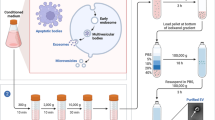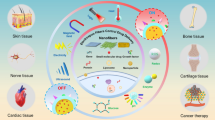Summary
Proline analogues inhibit procollagen triple helix formation and are antifibrotic in vivo. Efficacy of the proline analoguecis-4-hydroxy-L-proline (cHyp) on vascular collagen accumulation is improved by in vivo delivery in liposomes. This effect may be due to local release of drug from liposomes taken up by vascular endothelium. To test this postulate, we used a co-culture system to assess the antifibrotic effect of cHyp in liposomes taken up by endothelium (upper well) by measuring inhibition of growth of smooth muscle cells and fibroblasts (lower well). We also studied whether release of cHyp was prolonged in poly(ethyleneglycol) (PEG)-conjugated liposomes compared to liposomes not conjugated with PEG (control liposomes). In fibroblasts, free (unencapsulated) cHyp (1 mg/ml) added to the upper well inhibited growth for 3 days; an equivalent dose of cHyp in control liposomes inhibited growth for 4 days. cHyp in PEG-liposomes produced greater growth inhibition than cHyp in control liposomes. cHyp in liposomes did not inhibit growth of smooth muscle cells more than free cHyp. Washing free cHyp from endothelium after 1 day incubation restored growth of smooth muscle cells whereas washing liposomes containing cHyp failed to restore cell growth. These results suggest that liposomes enhance drug efficacy of cHyp by prolonging the release of drug from endothelium.
Similar content being viewed by others
References
Allen T, Chonn A (1987) Large unilamellar liposomes with low uptake into the reticuloendothelial system. FEBS Lett 223: 42–46
Allen TM, Hansen C, Martin F, Redemann C, Yau-Young A (1991) Liposomes containing synthetic lipid derivatives of poly(ethyleneglycol) show prolonged circulation half-lives in vivo. Biochem Biophys Acta 1066: 29–36
Ames BN, Dubin DT (1960) The role of polyamines in the neutralization of bacteriophage deoxyribonucleic acid. J Biol Chem 125: 769–775
Berg RA, Schwartz ML, Crystal RG (1980) Regulation of the production of secretory proteins: Intracellular degradation of newly synthesized “defective” collagen. Proc Natl Acad Sci USA 77: 4746–4750
Blume G, Cevc G (1990) Liposomes for the sustained drug release in vivo. Biochem Biophys Acta 1029: 91–97
Bora FW Jr, Lane JM, Prockop DJ (1972) Inhibitors of collagen biosynthesis as a means of controlling scar formation in tendon injury. J Bone Joint Surg 54A: 1501–1508
Chen PS, Toribara TY, Werner H (1956) Microdetermination of phosphorus. Anal Chem 28: 1756–1758
Duncan DB (1975) t-Tests and intervals for comparisons suggested by the data. Biometrics 31: 339–359
Fuller GC (1981a) The pharmacology and toxicology of antifibrotic agents. In: Gerlach U, Pott G, Rauterberg J (eds) Connective tissue of the normal and fibrotic human lung. Thieme, Stuttgart, pp 219–231
Fuller GC (1981b) Prospectives for the use of collagen synthesis inhibitors as antifibrotic agents. J Med Chem 24: 651–658
Gabizon A, Papahadjopoulos D (1988) Liposome formulations with prolonged circulation time in blood and enhanced uptake by tumors. Proc Natl Acad Sci USA 85: 6949–6953
Gean KF, Poiani GJ, Riley DJ, Kohn J (1992) New polymeric carriers ofcis-hydroxy-L-proline: Potential agents for the inhibition of excess collagen synthesis. Polymer Preprints 33/2: 51–52
Geismar LS, Kerr JS, Trelstad RL, Riley DJ (1988) Treatment of experimental silicosis with antifibrotic agents. Toxicology 53: 331–344
Jaffe EA, Hoyer LW, Nachman RL (1973) Synthesis of antihemophilic factor antigen by cultured human endothelial cells. J Clin Invest 52: 2757–2764
Jayasuriya N, Bosak S, Regan SL (1990) Design, synthesis, and activity of membranedisrupting bolaphiles. J Am Chem Soc 112: 5844–5850
Kalir R, Fridkin M, Patchornik A (1974) (4-Hydroxy-3-nitro)benzylated polystyrene. An improved polymeric nitrophenol derivative for peptide synthesis. Eur J Biochem 42: 151–156
Kao WW-Y, Prockop DJ (1977) Proline analogue removes fibroblasts from cultured mixed cell populations. Nature 266: 63–64
Kerr JS, Ruppert CL, Tozzi CA, Neubauer JA, Frankel HM, Yu SY, Riley DJ (1987) Reduction of chronic hypoxic pulmonary hypertension in the rat by an inhibitor of collagen production. Am Rev Respir Dis 135: 300–306
Klivanov AL, Maruyama K, Torchilin VP, Huang L (1990) Amphipathic polyethyleneglycols effectively prolong the circulation time of liposomes. FEBS Lett 268: 235–237
Mayne R (1987) Vascular connective tissue: normal biology and derangement in human diseases. In: Uitto J, Perejda AJ (eds) Connective tissue disease: molecular pathology of the extracellular matrix. Marcel Dekker, New York, pp 163–184
Pagano RE, Weinstein JN (1978) Interaction of liposomes with mammalian cells. Annu Rev Biophys Bioeng 7: 435–468
Poiani GJ, Tozzi CA, Choe JK, Yohn SE, Riley DJ (1990) An antifibrotic agent reduces blood pressure in established pulmonary hypertension in the rat. J Appl Physiol 68: 1542–1547
Poiani GJ, Wilson FJ, Fox JD, Sumka JM, Peng BW, Liao W-C, Tozzi CA, Riley DJ (1992) Liposome-entrapped antifibrotic agent prevents collagen accumulation in hypertensive pulmonary arteries of rats. Circ Res 70: 912–922
Poste G, Bucana C, Raz A, Bugelshi P, Kirsh R, Fiedler IJ (1982) Analysis of the fate of systemically administered liposomes and implications for their use in drug delivery. Cancer Res 42: 1412–1422
Riley DJ, Berg RA, Edelman NH, Prockop DJ (1980) Prevention of collagen deposition following pulmonary oxygen toxicity in the rat bycis-4-hydroxy-L-proline. J Clin Invest 65: 643–651
Riley DJ, Kerr JS, Berg RA, Ianni BD, Pietra GC, Edelman NH, Prockop DJ (1981) Prevention of bleomycin-induced pulmonary fibrosis in the hamster bycis-4-hydroxy-L-proline. Am Rev Respir Dis 123: 388–393
Riley DJ, Kerr JS, Yu SY (1984) Effect of proline analogues on oxygen toxicity-induced pulmonary fibrosis in the rat. Toxicol Appl Pharmacol 75: 554–560
Rojkind M (1973) Inhibition of liver fibrosis by L-azetidine-2-carboxylic acid in rats treated with carbon tetrachloride. J Clin Invest 52: 2451–2456
Ryan US (1988) Phagocytic properties of endothelial cells. In: Ryan US (ed) Endothelial cells, vol III. CRC Press, Boca Ration, FL, pp 33–49
SAS/STAT® User's Guide (1990), vol 2, 4th edn. SAS® Institute, Cary, NC, pp 891–996
Szoka F Jr, Papahadjopoulos D (1978) Procedure for preparation of liposomes with large internal aqueous space and high capture by reverse-phase evaporation. Proc Natl Acad Sci USA 75: 4194–4198
Turrens JF, Crapo JD, Freeman BA (1984) Protection against oxygen toxicity by intravenous injection of liposome-entrapped catalase and superoxide dismutase. J Clin Invest 73: 87–95
Uitto J, Prockop DJ (1975) Inhibition of collagen accumulation by proline analogues: the mechanism of their action. In: Popper M, Becker K (eds), Collagen metabolism in the liver. Stratton, New York, pp 139–148
Uitto J, Hoffmann H-P, Prockop DJ (1975) Retention of nonhelical procollagen containingcis-hydroxyproline in rough endoplasmic reticulum. Science 190: 1202–1204
Uitto J, Tan EML, Ryhänen L (1982) Inhibition of collagen accumulation in fibrotic processes: review of pharmacological agents and new approaches with amino acids and their analogues. J Invest Dermatol 79: 1135–1205
Wilson MJ, Hatfield DL (1984) Incorporation of modified amino acids into proteins in vivo. Biochim Biophys Acta 781: 205–215
Woodle MC, Newman M, Collins L, Redemann C, Martin F (1990) Improved long circulating (STEALTH) liposomes using synthetic lipids. Proc Int Soc Control Rel Bioact Mater 17: 77–78
Zalipsky S, Seltzer R, Nho K (1991) Succinimidyl carbonates of polyethylene glycols. In: Dunn RL, Ottenbrite RM (eds) Polymeric drugs and drug delivery systems, ACS symposium series, vol 469. American Chemical Society, Washington, DC, pp 91–100
Author information
Authors and Affiliations
Rights and permissions
About this article
Cite this article
Poiani, G.J., Gean, K.F., Fox, J.D. et al. Antifibrotic effect of a proline analogue delivered in liposomes to cells in culture. Amino Acids 4, 237–248 (1993). https://doi.org/10.1007/BF00805825
Received:
Accepted:
Issue Date:
DOI: https://doi.org/10.1007/BF00805825




